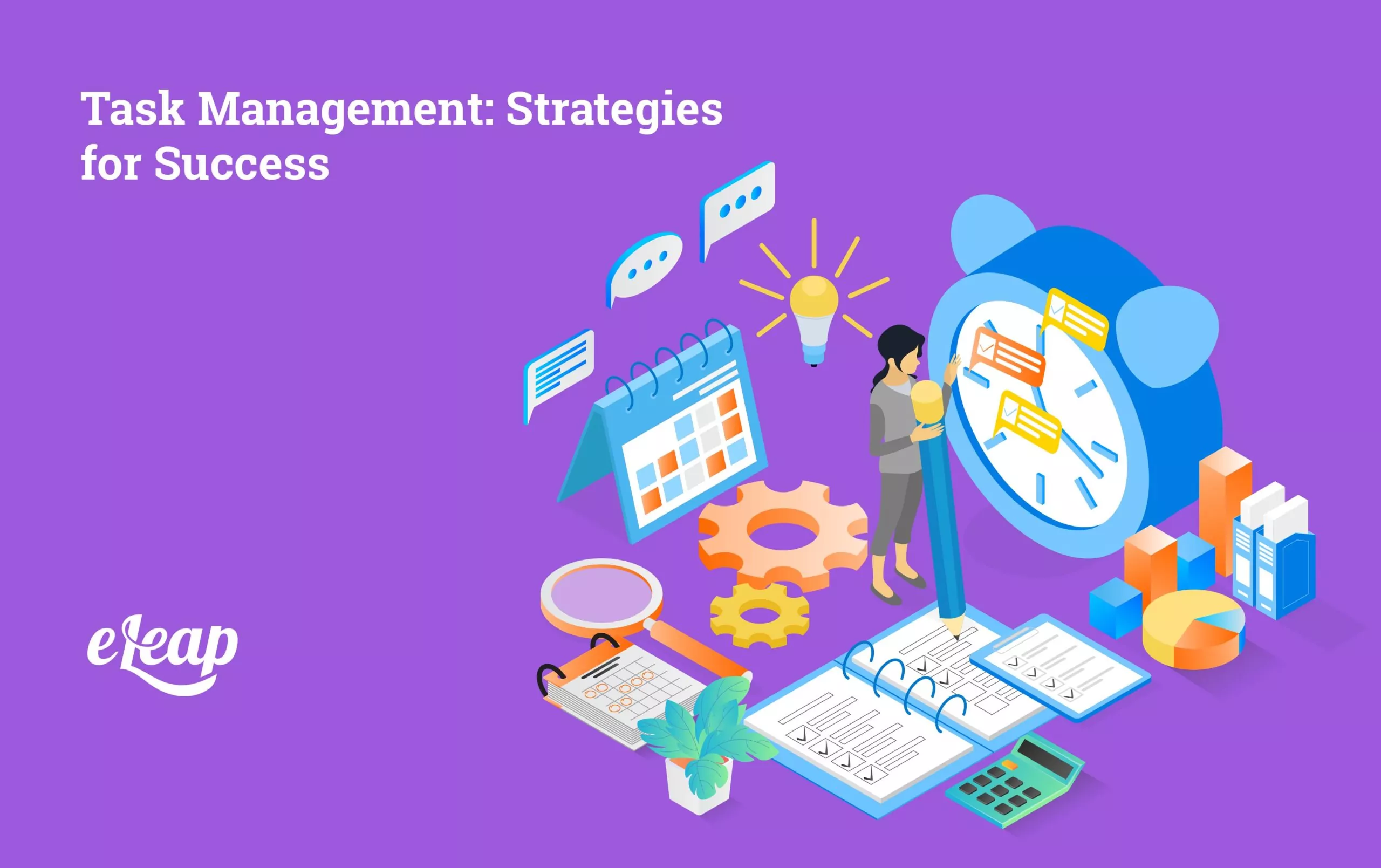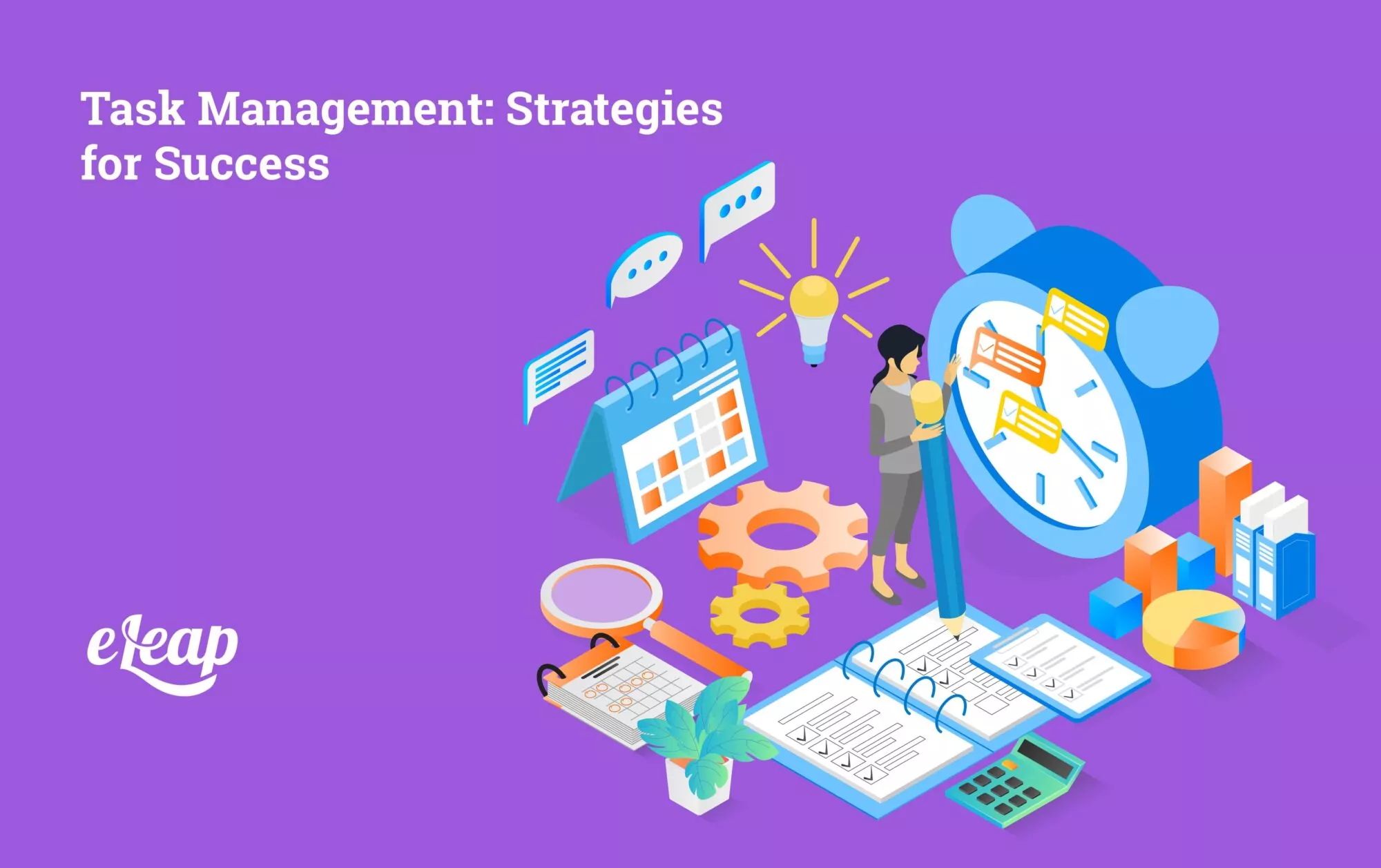Task Management: Strategies for Success

Task management is essential for individuals and businesses seeking efficiency and productivity. It refers to organizing and planning tasks to achieve specific goals effectively. Regardless of industry, good task management can have a transformative impact on personal productivity and team success. This article explores strategies for successful task management and offers actionable insights to help you streamline your workflow, overcome common obstacles, and ultimately boost your performance. Explore how eLeaP®’s Performance Management Platform can simplify evaluations, boost productivity, and drive measurable results.
What is Task Management?
Task management is the process of planning, organizing, and executing tasks to achieve goals within a set time frame. It involves prioritizing tasks, allocating resources, tracking progress, and evaluating task completion. Effective task management is vital for optimizing productivity, meeting deadlines, and reducing stress in personal and professional settings.
The core principle of task management is to simplify and organize tasks so that each step contributes directly to the desired result. Task management guarantees that time and effort are spent efficiently, reducing the chances of distractions or wasted resources.
The Psychology Behind Effective Task Management
The psychological impact of managing tasks effectively cannot be understated. When we have a clear, organized plan, we reduce cognitive load, which is the mental effort required to process information. A well-managed task list can alleviate stress, improve decision-making, and enhance creativity.
Studies suggest that task management can help individuals with ADHD and anxiety disorders by providing structure and routine. By breaking tasks into manageable steps and tracking progress, task management reduces the overwhelming feeling of “too much to do,” allowing for a more explicit focus on the immediate next step.
Proven Strategies for Effective Task Management
Successful task management hinges on the application of proven strategies. Here, we discuss several key approaches that can drastically improve task management, individually or as part of a team.
Goal Setting for Task Management Success

One of the most essential strategies in task management is goal setting. Goals act as a clear map that directs every task, decision, and action. Without clearly defined goals, tasks may become aimless, wasting time and energy.
The SMART Goals framework is a great way to structure your goals. SMART stands for Specific, Measurable, Achievable, Relevant, and Time-bound. By ensuring each task aligns with these principles, you can create a roadmap that guides your daily actions toward achieving broader objectives.
It’s essential to break larger goals into smaller, more manageable tasks. This practice prevents you from feeling overwhelmed and ensures you consistently move toward the outcome. Although the larger objective may seem daunting initially, dividing it into manageable pieces makes it much easier to navigate.
The Power of Prioritization
Prioritization is a fundamental component of effective task management. Without prioritization, tasks can become jumbled, with some being worked on out of sequence. This process can lead to missed deadlines, low-quality output, and frustration. Prioritization allows you to focus on the most impactful tasks and address them first.
One standard tool for prioritization is the Eisenhower Matrix. It helps you categorize tasks based on urgency and importance. Tasks can be divided into four categories: urgent and important, important but not urgent, urgent but not necessary, and neither urgent nor essential. This method helps you focus on high-priority items while delegating or postponing less crucial tasks.
Another helpful approach is the ABCDE method, which categorizes from A (most important) to E (least significant). This simple yet effective method allows you to tackle tasks in order of importance.
Breaking Tasks into Actionable Steps
Large tasks seem overwhelming, so breaking them into smaller, more manageable steps is crucial. This process of “chunking” allows you to focus on one action at a time without feeling burdened by the overall scope of the task.
For example, if you’re tasked with organizing a conference, you might break the task into steps like “secure a venue,” “invite speakers,” “create marketing materials,” and “register attendees.” Each task is manageable, and completing them leads to achieving the larger goal.
Focusing on smaller tasks reduces procrastination and increases momentum. The accomplishment of ticking off smaller items from your to-do list can motivate you to continue working.
Time Blocking: Maximizing Focus and Efficiency
Time blocking is another powerful strategy for managing tasks. It involves setting aside specific blocks of time for specific tasks or activities, ensuring that you focus solely on one task at a time. This method is beneficial for eliminating distractions and ensuring deep work.
One approach to time blocking is the Pomodoro Technique, which involves working in 25-minute intervals followed by a short break. After four intervals, you take a more extended break. This structure maximizes focus during work periods and prevents burnout during breaks.
Time blocking helps you allocate time specifically for high-priority tasks, preventing less important activities from crowding your schedule. It also lets you track the time it takes to complete tasks, helping you improve your time estimation for future planning.
Task Management Tools: Streamlining Your Workflow
Incorporating the proper task management tools can significantly streamline your workflow. These tools automate many aspects of activity oversight, allowing for smoother organization and communication. With so many tools available, finding the right one for your needs is essential.
Why Use Task Management Software?
Task management software centralizes your task list in one place. Rather than juggling multiple notebooks, spreadsheets, or apps,activity oversight tools allow you to track tasks, set deadlines, and communicate progress seamlessly.
These tools also help automate recurring tasks, send reminders, and generate reports that provide insight into team performance. By automating certain aspects of task management, you can reduce mental clutter and focus on tasks that require creativity or problem-solving.
Top Task Management Tools and Features
Popular tools like Asana, Trello, and ClickUp offer various features that allow users to assign tasks, track deadlines, and collaborate with team members. Each tool has unique strengths, so choosing the right one depends on your needs.
For example, Asana is excellent for managing complex projects, while Trello uses a simple, board-based layout ideal for visual learners. ClickUp offers an all-in-one platform for activity oversight, document sharing, and collaboration. Experimenting with these tools and identifying which best suits your team’s workflow is essential.
Mobile vs. Desktop Task Management Apps
Task management apps aren’t limited to desktops. Many tools also offer mobile apps, allowing you to manage tasks on the go. The flexibility of mobile apps means that even while away from the office, you can check off tasks, assign new ones, and collaborate with your team in real time.
However, mobile apps have screen size and functionality limitations, making desktop apps more suitable for detailed project management. When selecting a tool and platform, consider your team’s working style.
Managing Common Task Management Challenges
Even with the best system, Activity Oversight can still be challenging. Here are common obstacles and strategies for overcoming them.
Overcoming Procrastination and Task Aversion
Procrastination is one of the most common obstacles to effective activity oversight. When faced with a difficult or undesirable task, it’s easy to put it off in favor of something more enjoyable. However, procrastination often leads to rushed work and unnecessary stress.
To combat procrastination, break tasks into smaller, manageable chunks and focus on completing one small part at a time. Another helpful technique is the “two-minute rule,” which suggests that if a task can be completed in two minutes or less, do it immediately.
Managing Overwhelm and Multiple Priorities
When multiple tasks compete for your attention, staying organized can feel impossible. To manage this, try using a priority matrix to focus on tasks that contribute most to your goals. Delegating tasks can lighten your workload and help you focus on high-priority tasks.
Navigating Interruptions and Staying on Track
Interruptions are inevitable, especially in a busy work environment. The key to handling interruptions is staying flexible and adjusting your plans. Techniques like time blocking or the Pomodoro method can help you create buffers for unforeseen interruptions while maintaining focus.
Advanced Task Management Practices
Once you’ve mastered the basics of task management, you can apply more advanced practices to improve efficiency and performance further.
Incorporating Agile Methodologies for Task Management
Agile methodologies are often used in software development but can be applied to any project management context. Agile emphasizes flexibility, collaboration, and incremental progress, which can help teams respond quickly to changing demands.
Using agile principles allows you to break large projects into smaller sprints, allowing continuous progress and feedback. This iterative approach helps teams remain adaptable and ensures no task is left behind.
Building a Collaborative Task Management System
Effective task management is rarely a solo endeavor. Collaboration tools like eLeaP help facilitate teamwork by enabling real-time task sharing, tracking, and communication. A collaborative system ensures that everyone on the team knows their responsibilities and deadlines, improving accountability and reducing confusion.
Data-Driven Task Management: Tracking Performance
The best task managers use data to track their progress. You can assess where resources are most effective by measuring the time spent on various tasks. This data can also highlight areas where tasks take longer than expected, prompting necessary adjustments to improve efficiency in future tasks.
Task Management for Personal vs. Team Productivity
Effective task management is essential not only for individual productivity but also for team success.
Task Management for Individuals
Task management helps individuals stay organized and meet deadlines. The key to personal job supervision is setting realistic goals, using effective prioritization techniques, and maintaining focus.
Task Management for Teams
Task management in teams involves dividing tasks appropriately and ensuring everyone is on the same page. Tools like eLeaP facilitate team collaboration by enabling real-time task assignment and monitoring. Good communication is essential for effective task management in teams.
How to Stay Consistent and Build Task Management Habits
Consistency is the key to mastering task management. A daily routine helps embed task management into your workflow, ensuring long-term success.
The Role of Routine in Task Management Success
A well-structured routine ensures you stay on track. Whether you start each day with a planning session or review your goals weekly, routine provides a foundation for success. Routine doesn’t mean rigidity—it’s about creating a rhythm that helps you accomplish tasks efficiently.
Reviewing and Adjusting Your Task Management System
It’s essential to revisit your Activity Oversight system over time. Regular reviews help you adjust to new challenges and ensure your methods continue serving your needs. This iterative process fosters continuous improvement.
Conclusion
Mastering task management is not a one-time effort; it’s an ongoing process. You can significantly enhance your productivity by applying the above strategies, utilizing the right tools, and staying consistent. Whether managing personal projects or leading a team, effective task management is the key to achieving your goals and maximizing success.